Moniek Bloks's Blog, page 16
May 6, 2025
Ernestine Charlotte of Nassau-Siegen – Princess & Portrait Painter
Ernestine Charlotte of Nassau-Siegen was born on 23 October 1623 as the daughter of John VIII, Count of Nassau-Siegen and Ernestine Yolande of Ligne.
She was probably born in Brussels. Her siblings were: Maria (1619-1620). an unnamed sister (born and died 1620), Claire Marie (1621 -1695), Lamberta Albertine (1625-1635) and Johann Franz Desideratus (1627-1699). Her father converted to the Catholic faith, and the family lived mostly in the Spanish Netherlands while he was in the service of Spain. He became an Imperial Field Marshall in 1629 and a Knight in the Order of the Golden Fleece in 1630. He was not close to his ancestral county of Nassau-Siegen, but he was even more loyal to Spain. Isabella Clara Eugenia, the Governor of the Habsburg Netherlands, was the godmother to Ernestine Charlotte’s sister, Claire Marie.1 Ernestine Charlotte and her siblings spent their youth in the Nassau Palace in Brussels and the Renaix estate near Oudenaarde.
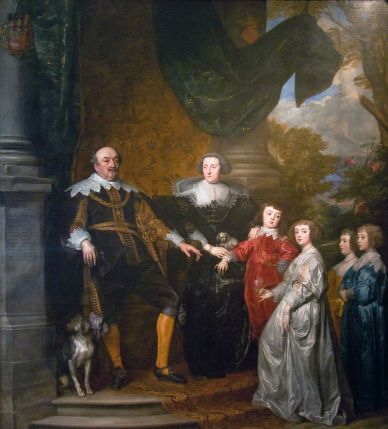 Ernestine Charlotte is the one in yellow (public domain)
Ernestine Charlotte is the one in yellow (public domain)The family was painted by Anthony van Dyck in 1634. It is not clear if Ernestine Charlotte had already developed a love for portrait painting back then, but it would certainly grow in the years to come. The family lived in luxury, but they were still in the shadow of more prestigious families of the time. In the same year as the family portrait, Claire Marie married Albert Henri, 2nd Prince of Ligne. She was widowed 7 years later and married her husband’s brother and successor, Claude Lamoral, 3rd Prince of Ligne. Ernestine Charlotte’s other sister, Lamberta Albertina, died in 1635, leaving Ernestine Charlotte as the only unmarried daughter when her father’s luck turned. He was stripped of his command in 1637 and died at Renaix after fighting the French on 27 July 1638.
Both Claire Marie and Ernestine Charlotte had an affinity for painting, but it is unclear from whom Ernestine Charlotte received her training as a painter. Her portraits appear to be influenced by Anthony van Dyck.2 It seems likely that her training came from someone in his circle at least. There appears to have been some contact with Gerard van Honthorst.3 Her future husband also had himself painted by Gerard van Honthorst.
Ernestine Charlotte painted several paintings of women, and they have survived to this day. Although these were unlikely to be intended as a series, they appear similar to a gallery of beauties. She also did a self-portrait, which can be seen at the top of this article. The women depicted were sometimes painted from life, but some were also based on other portraits, and they thus never posed for Ernestine Charlotte. She painted these between the years 1640 and 1650, and around 16 portraits are known.
Click to view slideshow.In 1640, Ernestine Charlotte’s future husband came to the Jesuit college in Brussels to study – his name was Maurice Henry, and he succeeded as Prince of Nassau-Hadamar in 1653. They were cousins and shared an ancestor in John VI, Count of Nassau-Dillenburg. His affection for her was apparently quite clear early on, but Ernestine Charlotte was more inclined towards the monastic life. Nevertheless, the two were engaged on 14 October 1649.4 Maurice Henry was an Imperial Colonel at the time of the engagement.
The two were married on 15 February 1650 at the Saint Jacques-sur-Coudenberg Catholic Church, following a papal dispensation that had been granted on 1 December 1648. There are no more known portraits by her following her marriage. The following June, they departed by ship to The Hague and then went up the Rhine and Lahn to Ems. Their final destination was Hadamar, where they were to take up residence. In Hadamar, Ernestine Charlotte was praised for her skills, and “this Princess is very clever in the same business and knows how to look for money properly.”5 She also managed to secure a lucrative position for her husband. Nevertheless, the transition from Brussels to Hadamar was difficult for her, and she was plagued by illnesses and constant pregnancies.
Ernestine Charlotte gave birth to her first child on 17 February 1651. It was a daughter who was named Ernestine Ludovika. She was already ill when she went into labour, and she remained quite ill for the following four weeks. Reports of illness continued throughout the year.6 In 1656, it was reported that she was dealing with a continuous indisposition and that she was often bedridden. She devoted herself to St Xavier for nine days, which brought on a period of recovery. She also often spent the summer months at Mengerskirchen.
Several more children followed over the years: Johann Lamoral (born 1653 – died 1654), Philipp Karl (born 1656 – died 1668), Franz Kaspar (born 1657 – died 1659), Claudia Franziska (born 1660 – died 1680) and Maximilian August (born 1662 – died 1663).
In 1667, she made her will and made a final trip to the Netherlands in May 1668. Her mother died at Renaix on June 1668. Shortly before their return to Hadamar, their eldest surviving son, Philipp Karl, died at the age of 13. Ernestine Charlotte became ill once again, complaining of stomach pains. She received the last rites on 15 August 1668 while she was at Mengerskirchen Castle. She died that day between 9 and 10 in the evening.
Most of her paintings made their way to the Lobkowicz collection in Prague due to Claudia Franziska’s marriage to Prince Ferdinand August von Lobkowitz. Some have ended up in Belgium and Germany.
The post Ernestine Charlotte of Nassau-Siegen – Princess & Portrait Painter appeared first on History of Royal Women.
Queen Camilla’s coronation portrait revealed
The coronation portrait of Queen Camilla has been revealed.
It is to form part of the royal collection and was painted by Paul S. Benney. The portrait will hang in the National Gallery until June 5th. It will then move to the Throne Room at Buckingham Palace, where it can be seen during the summer opening of the palace alongside King Charles’s coronation portrait.
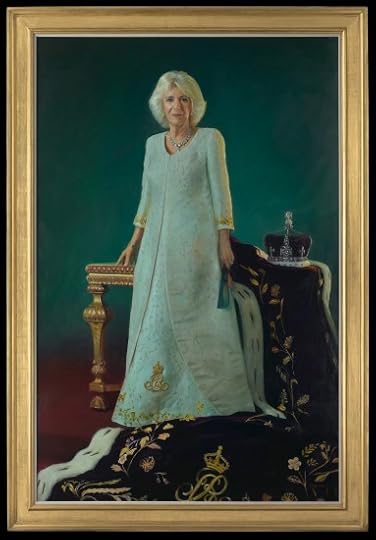 ©
©His Majesty King Charles III 2025; Photograph: Royal Collection Enterprises Ltd
Paul Benny said, “It was an honour, privilege and total pleasure to undertake the first official portrait of Her Majesty since The Coronation and it is with some regret that the sittings for this important commission have come to end. After nearly a year of being installed in a temporary studio at Clarence House, I have deep and abiding memories of many hours of fascinating and sometime hilarious conversation with Her Majesty on countless varied subjects. I shall miss the quiet and relaxed atmosphere while I was working there even when Their Majesties were engaged elsewhere.
“My guiding principles in this commission were to both acknowledge the grand and historic nature of The Coronation iconography with all the equipage of the Monarchy and at the same time reveal the humanity and empathy of such an extraordinary person taking on an extraordinary role.”
The post Queen Camilla’s coronation portrait revealed appeared first on History of Royal Women.
May 5, 2025
Royal Wedding Recollections – Princess Margaret of the United Kingdom & Antony Armstrong-Jones
Princess Margaret of the United Kingdom and Antony Armstrong-Jones were married on 6 May 1960 at Westminster Abbey in the first-ever televised British royal wedding.
As her father, King George VI, had already died, she was escorted to the altar by her brother-in-law, the Duke of Edinburgh. They had arrived in the Glass Coach, travelling from Clarence House.
Embed from Getty ImagesPrincess Margaret was dressed in a silk organza Norman Hartnell gown, and she wore the Poltimore Tiara, which she had only purchased the year before. She also wore a diamond riviére, which was a gift from her grandmother, Queen Mary.
She was accompanied up the aisle by eight bridesmaids: The Princess Anne, Miss Angela Nevill, Lady Rose Nevill, The Hon. Catherine Vesey, Miss Sarah Lowther, Lady Virginia Fitzroy, Miss Annabel Rhodes, and Miss Marilyn Wills.
Embed from Getty ImagesIn addition to family and friends of the friend and groom, several members of foreign royal families were also in attendance, such as the Queen of Denmark.
Embed from Getty ImagesThe Archbishop of Canterbury, Dr Geoffrey Fisher, led the traditional Church of England service.
After the service, they travelled to Buckingham Palace for a wedding breakfast with their guests.
A year after the wedding, Antony was raised to the peerage with the titles Earl of Snowdon and Viscount Linley. The couple went on to have two children together before divorcing in 1978.
The post Royal Wedding Recollections – Princess Margaret of the United Kingdom & Antony Armstrong-Jones appeared first on History of Royal Women.
May 4, 2025
Imperial Consort Qi – The Imperial Consort who became the Toilet Goddess
Imperial Consort Qi was Emperor Gaozu of the Western Han Dynasty’s favourite Imperial Consort. Her son, Prince Liu Ruyi, almost became Emperor of China. However, she is most famous for her gruesome and tragic death at the hands of Empress Dowager Lu Zhi.[1] Modern historians are beginning to doubt the accuracy of historical sources regarding Imperial Consort Qi’s tragic end.[2] After Empress Dowager Lu Zhi died, the Lu clan was mostly wiped out, and they had a negative reputation that would endure for centuries.[3] Empress Dowager Lu Zhi is often depicted as a “vengeful, murdering femme fatale and an exemplar of the problems that occur when a woman is allowed to hold power.”[4] Therefore, modern historians believe that Imperial Consort Qi’s death may be less gruesome than what is often depicted in ancient historical sources.[5]
In circa 220 B.C.E., Imperial Consort Qi was born in Dingtao (northwest of modern-day Dingtao District in Shandong Province).[6] Her early life is unknown.[7] She became an Imperial Consort to Emperor Gaozu of the Western Han Dynasty (r. 202-195 B.C.E.). In 208 B.C.E., Imperial Consort Qi bore Emperor Gaozu a son named Prince Liu Ruyi. Liu Ruyi would later be made the Prince of Zhao.[8]
Emperor Gaozu wanted to make Liu Ruyi the Crown Prince instead of his eldest son, Prince Liu Ying (the future Emperor Hui).[9] This was because he was disappointed with Prince Liu Ying because of his gentle temperament.[10] Because Emperor Gaozu wanted to replace Prince Liu Ying as Crown Prince in favour of Prince Liu Ruyi, it created tension between Imperial Consort Qi and Empress Lu Zhi.[11] Imperial Consort Qi accompanied Emperor Gaozu whenever he left the capital.[12] Empress Lu Zhi stayed behind in the capital and rarely saw her husband.[13]
On 1 June 195 B.C.E., Emperor Gaozu died of illness. With the support of Emperor Gaozu’s ministers, Empress Lu Zhi managed to secure her son’s throne.[14] Liu Ying ascended the throne as Emperor Hui. Therefore, Imperial Consort Qi lost the battle in making her son, Prince Liu Ruyi, the next Emperor.[15] After her son’s enthronement, Empress Dowager Lu Zhi imprisoned Imperial Consort Qi in Yongxiang Palace.[16] Her head was shaven.[17] She wore an iron ring around her neck and wore prisoner’s clothes.[18] She was forced to pound rice.[19]It was said that Imperial Consort Qi composed a song.[20] It went: “My son is a prince, but I am a prisoner pounding rice all day long and often in the company of death. We live a thousand li apart. Who should I send to tell you of this?”[21]
Imperial Consort Qi’s song enraged Empress Dowager Lu Zhi. Empress Dowager Lu Zhi poisoned Prince Liu Ruyi with wine.[22] Then, Emperor Lu Zhi cut off Imperial Consort Qi’s hands, feet, and eyes.[23] She deafened her ears and made her mute by filling her throat with wine full of poison.[24] Before Empress Dowager Lu Zhi killed her in 194 B.C.E., Imperial Consort Qi was thrown in a small room (though some historical sources call it a “toilet”).[25] As a last insult, Empress Dowager Lu Zhi called her a “human pig.”[26]
It is hard for modern historians to determine the actual fate of Imperial Consort Qi.[27] This is because ancient chroniclers wanted to paint Empress Dowager Lu Zhi in the most negative light possible.[28] It was unseemly for a woman to rule.[29] Imperial Consort Qi’s story was a morality tale to ensure that a woman like Empress Dowager Lu Zhi could never take power.[30] Many people have sympathized with Imperial Consort Qi.[31] For centuries, many people in China have worshipped Imperial Consort Qi as the “Toilet Goddess.”[32]
Sources:
Brown, Kerry. (2014). Berkshire Dictionary of Chinese Biography. (Brown, K., Ed). Great Barrington, Massachusetts: Berkshire Publishing Group.
McMahon, K. (2013). Women Shall Not Rule: Imperial Wives and Concubines in China from Han to Liao. NY: Rowman and Littlefield.
Wang, L. (2015). “Qi, Concubine of Emperor Gaozu”. Biographical Dictionary of Chinese Women: Antiquity Through Sui, 1600 B.C.E. – 618 C.E.. (L. X. H. Lee, Ed.; A. D. Stefanowska, Ed.; S. Wiles, Ed.). NY: Routledge. pp. 185-186.
[1] McMahon, 2013
[2] Brown, 2014
[3] Brown, 2014
[4] Brown, 2014, p. 202
[5] Brown, 2014
[6] Wang, 2015
[7] Wang, 2015
[8] Wang, 2015
[9] McMahon, 2013; Wang, 2015
[10] Wang, 2015
[11] McMahon, 2013; Wang, 2015
[12] Wang, 2015
[13] Wang, 2015
[14] McMahon, 2013; Wang, 2015
[15] Wang, 2015
[16] Wang, 2015
[17] Wang, 2015
[18] Wang, 2015
[19] Wang, 2015
[20] Wang, 2015
[21] Wang, 2015, p. 185
[22] Wang, 2015
[23] Wang, 2015
[24] Wang, 2015
[25] Wang, 2015, p. 185
[26] Wang, 2015, p. 185
[27] Brown, 2014
[28] Brown, 2014
[29] Brown, 2014
[30] Brown, 2014
[31] Wang, 2015
[32] Wang, 2015, p. 186
The post Imperial Consort Qi – The Imperial Consort who became the Toilet Goddess appeared first on History of Royal Women.
May 3, 2025
Book News Week 19
Book News week 19 – 5 May – 11 May 2025

Dianaworld: An Obsession
Hardcover – 8 May 2025 (UK)
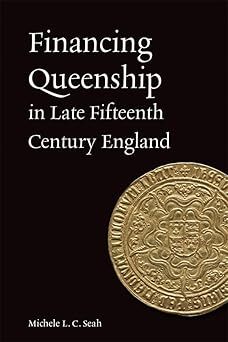
Financing Queenship in Fifteenth-Century England
Hardcover – 6 May 2025 (US & UK)
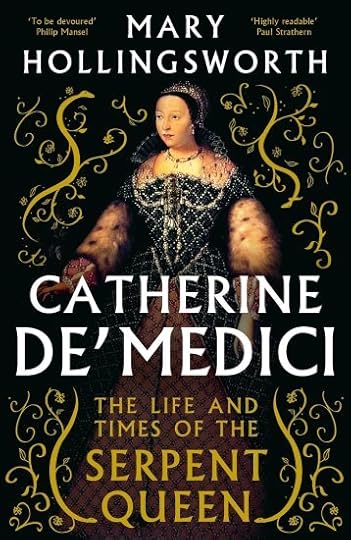
Catherine de’ Medici: The Life and Times of the Serpent Queen
Paperback – 8 May 2025 (UK)
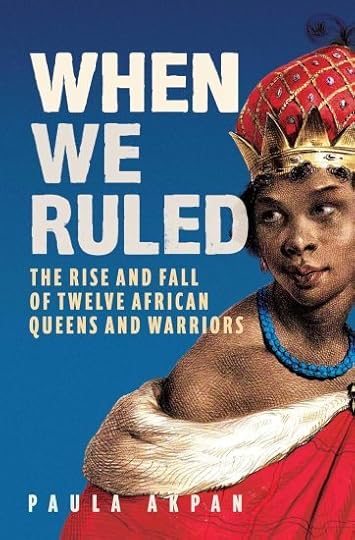
When We Ruled: The Rise and Fall of Twelve African Queens and Warriors
Hardcover – 8 May 2025 (UK)
The post Book News Week 19 appeared first on History of Royal Women.
King Charles and Queen Camilla coronation artwork revealed
Artwork from significant moments of the coronation of King Charles and Queen Camilla has been revealed for the first time. The second anniversary of the coronation is coming up.
Five artists were commissioned by King Charles to capture moments of the coronation weekend. Four alumni from the Royal Drawing School were selected for positions along the coronation route. Fraser Scarfe was outside Buckingham Palace, and Gideon Summerfield was at Trafalgar Square. Phoebe Stannard was at Westminster Abbey, and artist and illustrator Shana Lohrey was invited to Windsor Castle to capture the coronation concert. Eileen Hogan, an Emeritus Professor at the University of the Arts London and a Trustee of the Royal Drawing School, was commissioned to paint the Coronation Service itself from inside Westminster Abbey. She is the first woman to have been appointed in this role.
Click to view slideshow.Eileen Hogan said, “When I was appointed to paint the Coronation from Westminster Abbey, I was very aware that I was the first woman to be appointed in this historical role, and then I thought ‘What details could a painting bring that modern-day TV cameras could not?’. The more I thought about it, my conclusion was that the stillness of a painting really isolates and intensifies significant moments, and emphasises meaning; whether that be ritualistic, spiritual, or simply extremely human.”
Click to view slideshow.The artworks were presented to King Charles in September 2024 and have now been given to the Royal Collection.
The post King Charles and Queen Camilla coronation artwork revealed appeared first on History of Royal Women.
May 2, 2025
Lakshamilavan – The murdered Princess
Lakshamilavan, Princess consort of Siam, was one of the four wives of King Vajiravudh or Rama VI of Siam. Long after her glittering tenure, she met a tragic fate at the hands of her gardeners.
She was born Princess Wanphimon Worawan on 3 July 1899 as the daughter of Worawannakon, Prince Narathip Praphanphong, one of the numerous sons of King Mongkut, and Tat Montrikul. Not much is known about her youth, and she only entered the royal stage when her name was changed to Lakshamilavan at the orders of King Vajiravudh. He became engaged to her sister, whose name became Vallabha Devi. However, the engagement was broken off a few months later without a reason being given.
He married four women in quick succession. On 27 October 1921, he married Sucharit Suda. She never received the title of Queen. He also married Sucharit Suda’s sister, Indrasakdi Sachi. She fell pregnant quickly and was promoted to Queen, but she was demoted again when she lost the pregnancy and several others as well.
In 1922, he married Lakshamilavan, and she was given a title similar to that of Princess consort. In 1924, he finally married Suvadhana, who would be the only one to give him a living child – a daughter. Lakshamilavan never had a child with the King, and blaming herself, she retired from royal life not much later. The King died on 26 November 1925, just two hours after the birth of his daughter. He had decreed that the throne would pass to his younger brother Prajadhipok if he had a daughter.
Lakshamilavan inherited some money from the King and moved into the Laksami Vilas Villa. She spent her time writing and translating but was effectively a recluse by the end of her life.
She met a tragic end on 29 August 1961. The New York Times reported, “The police announced today that Princess Luxmami Lawan (sic) was found slain last night in the patio of her Bangkok palace. She was the sister of Prince Wan Waithayakon, Deputy Premier of Thailand. Authorities said that the 62-year-old Princess had been stabbed and beaten to death, apparently several days ago. They added that $5,000 in Thai currency had been stolen from the palace. They said that the Princess’s household staff of three men and two women had been missing since Tuesday. The police launched a nation-wide search for them.”1
She was later found to have been murdered for the King’s inheritance, or what remained of it, by her gardeners.2
The post Lakshamilavan – The murdered Princess appeared first on History of Royal Women.
May 1, 2025
Princess Thyra’s Sapphire Tiara
Princess Thyra’s Sapphire Tiara originally belonged to Princess Thyra of Denmark, one of the daughters of King Frederick VIII of Denmark.
It features five diamond elements with a central sapphire on a diamond base. It is made of both silver and gold, and the sapphires can be swapped for turquoise stones. It is unclear for whom it was originally created, but it was argued that this was either for Princess Thyra or her mother, Queen Louise.
Princess Thyra remained unmarried and left the tiara to her niece, Princess Caroline-Mathilde, who ended up marrying her first cousin, Knud, Hereditary Prince of Denmark. In turn, she left the tiara to her only daughter, Princess Elisabeth.1
Embed from Getty ImagesElisabeth retained her royal title, unlike her brothers, who married without royal assent, and she carried out some royal duties in Denmark. Princess Elisabeth died in 2018, and she likely left the tiara to her nieces. It was sold at auction in 2022 for €88,000.2
The post Princess Thyra’s Sapphire Tiara appeared first on History of Royal Women.
April 29, 2025
Anne Bowes-Lyon – A second Bowes-Lyon Royal (Part two)
When they wished to be married, there were some problems ahead. Danish princes were usually expected to renounce their titles when they wanted to marry commoners. They were then to be created a Count of Rosenborg, like Georg’s brother, Flemming. However, Prince Georg was rather reluctant to give up his royal title and begged King Frederik IX not to take it away. He received support from Anne’s uncle, King George VI, who told King Frederik, “If a Bowes-Lyon was good enough for me, a Bowes-Lyon is surely good enough for one of your princes.”1 The King of Denmark relented and gave his consent to the match. Then came the next issue: Anne was a divorcee, and the Archbishop of Canterbury informed them that no priest in the Anglican Church should marry them.
Eventually, the couple were married on 16 September 1950 by the priest of the Danish seamen’s church in Newcastle at the chapel of Glamis Castle in Scotland. Several royals attended the wedding, such as the future King Olav V of Norway and his daughters, Princess Astrid and Princess Ragnhild, Princess Josephine Charlotte of Belgium and Prince Carl Bernadotte of Sweden. Anne’s aunt, Queen Elizabeth, did not attend the ceremony, but she did attend the wedding reception with Princess Margaret. Upon marriage, Anne became known as Her Highness Princess Anne of Denmark.
The couple had an apartment in London next door to Prince Georg’s office. Due to his work, they moved around a lot in the following years and lived in a number of European cities. They also had a country house in Hertfordshire. In addition to his work at the Embassy, Prince Georg also carried out a number of royal duties. According to Anne’s son, she “now found herself with the perfect opportunity to exercise her expertise as the perfect hostess, a role which demanded skill, courage and savoir faire, particularly on the evenings when De Gaulle himself came to dinner.”2 Anne also joined her husband on royal engagements and he would later describe her as “my invaluable support through 30 years.”3 Whenever the Danish monarch went on a state visit, Georg would come along as attaché, and he would be joined by Anne. Despite having never lived in Denmark, Anne learned to speak almost fluent Danish.
Anne and Georg never had children together. Prince Georg later said, “Unfortunately, we have never had any mutual children, but I have always regarded my wife’s son and daughter as my own. They were quite young when I came into the family, and even though there, in our case, as in all other places, have been some disagreements between generations, I imagine we have had, and still have, an excellent relation between us.”4 In 1968, Prince Georg was asked to be the godfather of the future King Frederik X. They also loved spending time with the grandchildren.
Princess Anne last visited Denmark in April 1980 when Prince Georg celebrated his 60th birthday. She already had some health problems, but her death was still unexpected. She died in London on 26 September 1980 of a heart attack. She was only 62 years old.
Her body was brought to Copenhagen, and the funeral took place on 6 October at the Anglican St Alban’s Church. A memorial service was held in London, which was attended by Queen Elizabeth II, Queen Elizabeth the Queen Mother, King Olav V of Norway, and Queen Ingrid.
A Danish newspaper wrote, “On many occasions and in all parts of the world, Princess Anne has, together with her husband, in the finest way represented the Danish royal family and Denmark. This was a couple who, to a rare extent, complemented each other on the often complicated extrovert tasks, but privately as well, they supported each other in the finest way.”5
Prince Georg would not live long with his Anne; he died on 29 September 1986 after suffering a bad fall. Prince Georg and Princess Anne are buried together with Georg’s parents and brother in the park of Bernstorff Palace in a suburb of Copenhagen.
The post Anne Bowes-Lyon – A second Bowes-Lyon Royal (Part two) appeared first on History of Royal Women.
April 27, 2025
Anne Bowes-Lyon – A second Bowes-Lyon Royal (Part one)
Anne Bowes-Lyon was born on 4 December 1917 as the second child of The Honourable John Bowes-Lyon and Fenella Hepburn-Stuart-Forbes-Trefusis in Washington in the United States. Her father was stationed at the British Embassy in Washington after having been wounded in action. Her elder sister had died in infancy before her birth. Three younger sisters followed: Nerissa (born 1919), Diana (born 1923) and Katherine (born 1926).
Her father was an elder brother of Queen Elizabeth the Queen Mother, and he died quite young in 1930 of pneumonia. He left Fenella a widow with four young children, including two (Nerissa and Katherine) who were intellectually disabled. Their cousin, Lady Mary Clayton, said, “They were missing one vital nerve that connects the two halves of the brain, which meant that they could not grow up normally. They were incredibly beautiful little things and very sweet.”1 After their father’s death, Nerissa and Katherine were sent to a private school.
Anne was known to have visited her sisters in later years. Her daughter later said, “When Mother came home late in the evenings after a visit to the hospital [where the sisters lived], she was often terribly depressed. But Father [Anne’s second husband, Georg] sat and waited for her, and that meant everything to her. To have someone to talk to. Someone who would listen and understand.”2
There is little information about Anne’s education, and a news article on her wedding only reported that she was educated in England, France and Switzerland.3 She was still only 20 years old when she married for the first time. On 28 April 1938, she married Thomas Anson, Viscount Anson, who was the heir to the Earl of Lichfield. Thus, Anne became known as Viscountess Anson upon marriage.
The New York Times reported, “Queen Elizabeth’s 20-year-old niece, Miss Anne Ferelith Bowes-Lyon, was married to Viscount Anson here today. The Queen and the Princesses Elizabeth and Margaret Rose attended the white and silver wedding at St. Margaret’s Church, Westminster, close to Westminster Abbey. The royal party disappointed the crowd by entering a side door. Police, mounted and afoot, kept the throng away from the main entrance and were kept busy clearing railings and eager spectators. Many women fainted in the crush. The bride, a daughter of the late Hon. John Bowes-Lyon and Mrs. Bowes-Lyon, wore white satin with a train of old lace edged in silver. The Archbishop of Canterbury officiated.”4
Almost exactly one year later, Anne gave birth to her first child, a son named Thomas Patrick John Anson. A daughter was born on 7 June 1941, and she was named Elizabeth Georgiana in honour of Queen Elizabeth and King George VI. The King even stood as young Elizabeth’s godfather. The war years were a trying time for the family. Her husband was on service abroad, while Anne and the children moved around. They eventually settled in Shugborough in Staffordshire. Although her husband returned from the war, Anne promptly left the family home. It is unclear what exactly happened. Her son later wrote, “I will probably never know what happened between them, but the story, I suspect, was far from uncommon: two people, scarcely out of adolescence, meeting, falling in love, marrying, and then almost immediately, being parted by war. Five years later, when they were reunited, they’d become different people.”5
The divorce became final in 1948, and the New York Times reported, “Viscountess Anne Ferelith Fenella Anson, niece of Queen Elizabeth, won a conditional decree of divorce from Viscount Anson of the Grenadier Guards today on the grounds of desertion. She received custody of their two children. The couple married in 1938. She charged he had left her in January, 1945.”6 Anne settled in London, where she worked various jobs to make ends meet.
At a Shrovetide ball at the Swedish Embassy, Anne would meet the man who was to be her second husband, Prince Georg of Denmark. He was the son of Prince Axel of Denmark and Princess Margaretha of Sweden, making him a great-grandson of King Christian IX of Denmark. He was also a first cousin of King Harald V of Norway, King Baudouin of Belgium, and King Albert II of Belgium, as well as a second cousin of King George VI of the United Kingdom. Georg lived in London and worked as an Acting Military Attaché.
Part two coming soon.
The post Anne Bowes-Lyon – A second Bowes-Lyon Royal (Part one) appeared first on History of Royal Women.



